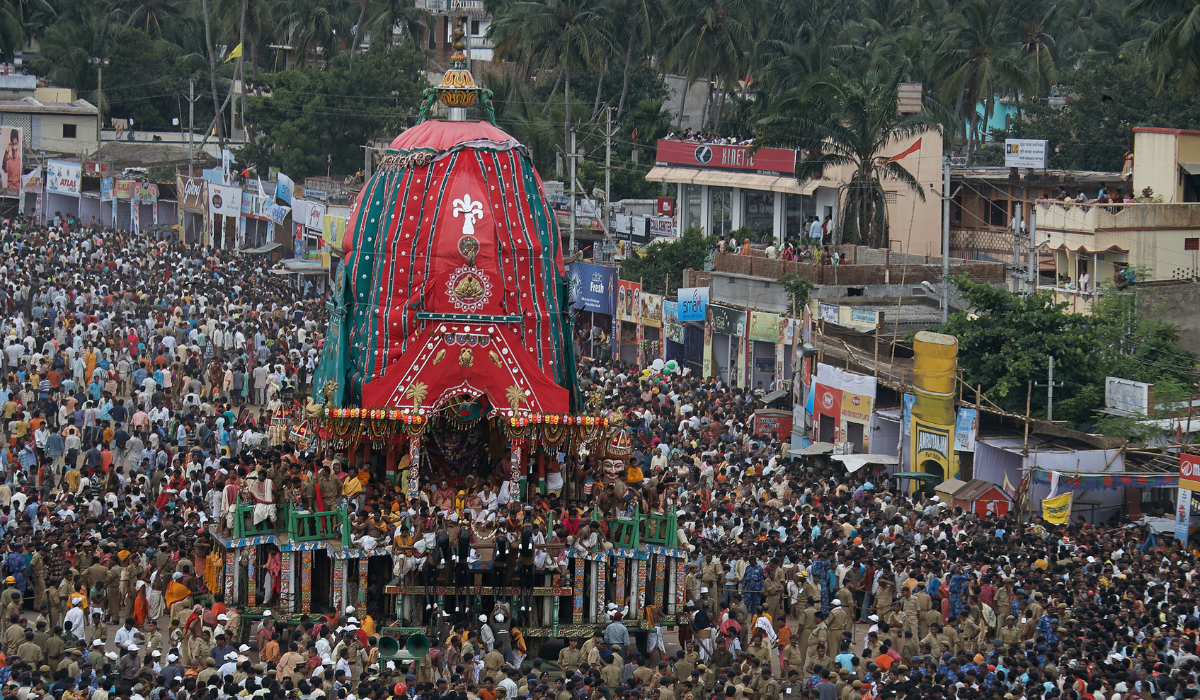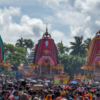The Rath Yatra of Lord Jagannath in Puri is a grand and mesmerizing festival rooted in several mythical stories reflecting the socio-religious beliefs of the region. Here are some of the chief legends associated with its origin:
Invitation to Mathura
Kansa, the maternal uncle of Krishna, once harbored a sinister wish to harm both Krishan and his brother Balarama. In a cunning move, Kansa disguised his genuine objectives by inviting them to Mathura. Kansa dispatched his charioteer, Akrura, to Gokul to make their trip easier.
Lord Krishan and Balarama were notified of Kansa’s invitation when Akrura arrived in Gokul. Krishna and Balarama got into the chariot without hesitation, prepared to travel to Mathura. Devoted followers commemorate this historic occasion of their departure from Gokul to Mathura as the Rath Yatra.
Victory over Kansa
Kansa, the maternal uncle of Krishan, always wanted to kill Krishan. To end his reign of terror, Krishna and Balaram defeated and killed Kansa, liberating the people of Mathura from his oppression. This event is celebrated as a significant victory of good over evil.
After the victory over Kansa, there was a grand celebration, and Krishna and Balaram gave darshan (holy appearance) to the people of Mathura on a chariot. This event is commemorated during the Rath Yatra, where the deities are paraded in grand chariots, symbolizing their victory and divine presence among the devotees.
Tour of Dwarika
It has been stated that Subhadra, the sister of Krishna and Balaram, expressed a desire to see the magnificent city of Dwarka. Krishna and Balaram decided to fulfill her wish and took her on a chariot ride around the city.
During this joyous journey, Subhadra was overwhelmed by the beauty and grandeur of Dwarka. This event is celebrated as the Rath Yatra, symbolizing the divine siblings’ journey and the display of the city’s splendor to Subhadra. According to the Bhagavata Purana, one of the most revered texts in Hinduism, it describes the close relationship between Krishna, Balaram, and Subhadra. Thus emphasizing the deep bond and divine roles of these siblings.
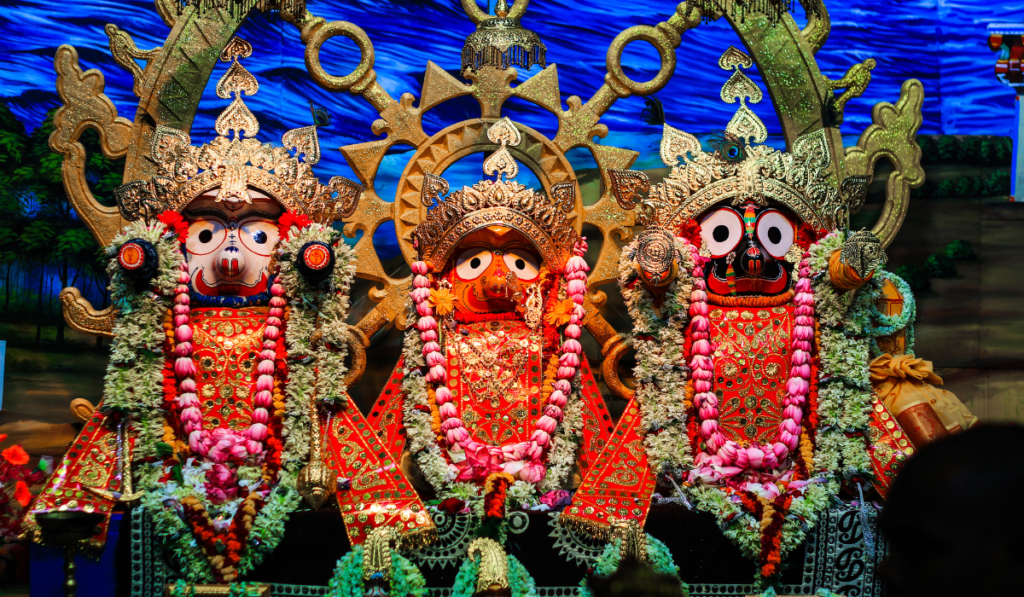
Ras Lila Story
According to Hindu mythology and the Puranas, the story behind the worship of Lord Jagannath, Balaram, and Subhadra in the Puri Temple is rooted in a fascinating episode involving Lord Krishna’s pastimes (leelas).
The unique nature of Krishna’s early existence and his enchanted activities with the Gopis in Vrindavan piqued the interest of his queens at Dwarka. The holy dances known as Ras Lila, which Krishna performed with the Gopis, piqued their curiosity in particular.
To listen to these stories, the queens approached Mother Rohini, who had witnessed these pastimes. Mother Rohini knows these stories are amorous, so she felt that it was inappropriate for Subhadra to hear them. She then sent Subhadra to guard the door while she narrated the stories to the queens.
Despite her position at the door, Subhadra was deeply curious about the stories. Soon, she, along with Krishan and Balaram, who had also come to listen, became engrossed in the divine narrations. They stood captivated, listening to the tales of Krishan’s love and divine play with the Gopis.
Upon witnessing Krishna, Balaram, and Subhadra standing together, the sage Narada widened his eyes. So, in this divine state of absorption, I prayed to them, requesting that this beautiful and divine sight of the three siblings standing together be made eternal. He wished that they be worshiped in this form for the benefit of devotees.
Krishan, Balaram, and Subhadra granted Narada’s wish. As a result, they are worshiped in this specific form in the Jagannath Temple in Puri. The idols in the temple reflect this divine manifestation, capturing the essence of the siblings’ divine presence and their unity.
Post-Cremation Legend
A long time ago, there lived a king called Indradyumna. He was a great devotee of Lord Krishna and always wanted to see the Lord. Once, Brahmin visited him and told him about a very holy place called Purushottam Kshetra. At this place, a beautiful form of Lord Krishan was worshiped.
Hearing this from the Brahmin, the King was elated. Immediately, he summoned his best men. Among them was a simple, humble Brahmin called Vidyapathi. This Brahmin was assigned the duty to explore this special place and find the deity called Nilamadhava.
Vidyapati was extremely excited and delighted. He was so lost in devotion and the thoughts of Nilamadhav that he never felt hungry or thirsty throughout the long journey.
After so many days of traveling, Vidyapati met a village chief named Viswabasu. Viswabasu was returning home after worshiping Nilamadhav, and his body was giving off a sweet fragrance and shining with blissful peace.
After a pleasant conversation with Vidyapti, Viswabasu invited Vidyapati home to offer him some prasadam. However, Vidyapati was reluctant to accept anything until he saw the divine form of Lord Nilamadhava.
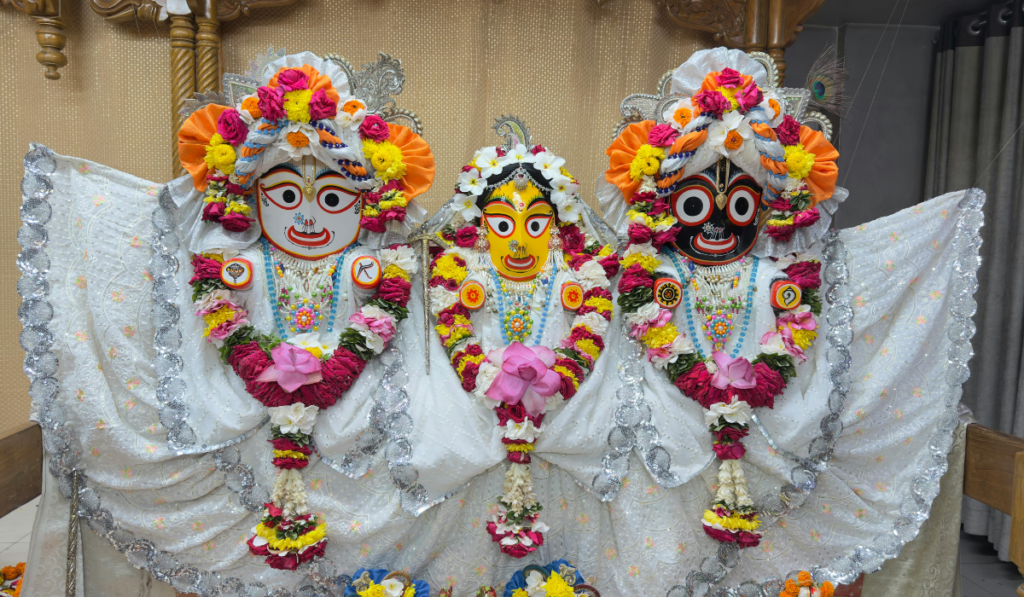
Viswabasu was quite reluctant to show Vidyapati at first, but in the end, he consented. He guided Vidyapati up a mountain and into a pitch-black forest. In the morning, following a strenuous nighttime stroll, they arrived at Nilachal Dham. Before taking him to that place, Vidyapati was blindfolded so that he didn’t see the path. However, Vidyapati took mustard seeds in his hands while going to the Nilachal Dham, thus forming a path for him to remember.
Seeing the enchanting deity of Nilamadhav, Vidyapati rushed towards it in ecstasy. Viswabasu prayed for his mercy and was thankful to be fortunate to have his darshan. After darshan, they came back to the home of the Viswabasu. Vidapati was respectfully offered many varieties of Prashad, and he was surprised to see many exotic dishes and asked to find out where they all came from. Then, Viswabasu explained that the Prashad was offered by the demigods to Lord Nilamahdav, who visited Nilachal Dham every day.
Once the humble priest Vidyapati had returned, he told King Indradyumna about his travels and presented the sacred prasadam of Nilamadhav—a fresh, sweet-scented flower garland. Another day, King Indradyumna set out for Nichal Dham with several others to meet the beautiful deity ‘Nilamadhav’. However, upon reaching there, they were shocked to see that the deity had disappeared. Instead of the deity, there was a heap of golden sand. The king became very distressed. Suddenly they heard a transcendental voice from the heavens informing them that the king would get the Lord’s divine darshan, but in a different form.
On the same night, King Indradyumna gets the darshan of Lord Vishu in his dream. The god instructed him to pick up the floating logs (dardu) from the ocean and carve the deities using those logs. Now, the question is: who will carve the deities?
Many of the best carpenters were invited to carve the deities; however, whenever the carpenters tried to work on the log, all their tools broke. Now, the king got worried and prayed for a solution. Again, he heard the transcendental voice. The voice told him that the old carpenter would come to carve the deities. The name of the carpenter was Vishwakarma, who is the architect of the gods themselves. The old man told the king that he would carve the deities within 21 days; however, he had one condition. He said the deities would be carved in a locked room, and no one would disturb him during this period. If anyone does so, he will disappear, irrespective of whether the idols were completed or not.
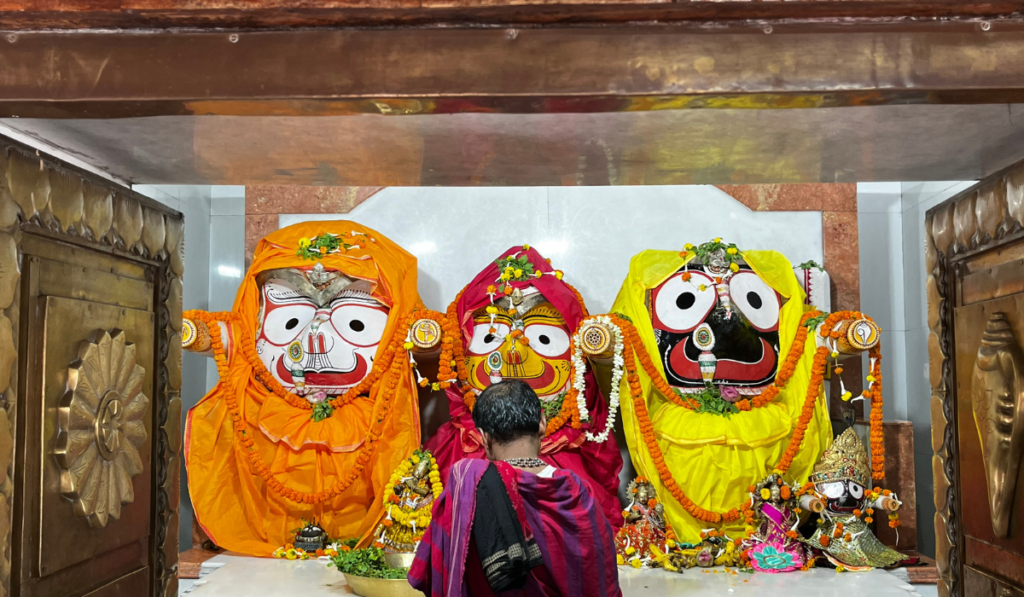
Thus, the elderly carpenter got to work. Every day, the sound of the chisel and hammer could be heard throughout the palace. But on the fourteenth day, the palace was silent. The Queen got worried about the old man and asked the King to look after him. The king resisted at first, but with each passing quiet minute, the king and queen grew increasingly agitated. They were convinced that something horrible had happened and that the old man’s health had affected his ability to work.
The king was standing outside the silent, closed chamber. The king listened through the door, his hand on the handle. As the king opened the door, the old man vanished. Inside the room, there remained three deities, with no hands and no feet.
Instantly, King Indradyumna regretted his rash decision and began to break down in despair. At that moment, Narada Muni appeared and comforted the king. He revealed that Lord Krishan desired to appear in this form as Lord Jagannath, Baladev, and Subhadra.
Thus, the deities still exist in the same avatar or form. Every 8, 12, or 19 years, due to some astronomical and astrological considerations, the images of the deities get replaced. The old idols were buried near the Koili Baikuntha. The last Nabakalebara took place in 2015, and millions of devotees witnessed the event.
Conclusion
The legends associated with Jagannath Puri not only enrich the spiritual and cultural heritage of the Jagannath Temple but also imbue the Rath Yatra with profound significance. Each legend contributes to the festival’s symbolism, rituals, and the deep sense of devotion felt by the participants, making the Rath Yatra a celebration of divine love, guidance, and renewal.
Each year, a majestic procession with these statues on giant chariots occurs from Jagannath Temple to the Gundicha Temple, Puri. This tradition is part of what makes the Jagannath Puri Temple one of the four sacred temples in India and the only one where the deities are siblings. Every 8, 12, or 19 years, the statues are replaced with new, also incomplete ones, continuing the unique tradition.
Let’s stay connected! Come say hi on Instagram or follow us on Facebook for daily inspo.
CATEGORIES

DIY
10 Post(s)

Fashion
3 Post(s)

Food
2 Post(s)

Health
4 Post(s)

Home Sweet Home
4 Post(s)
Spritual Pathways
3 Post(s)


